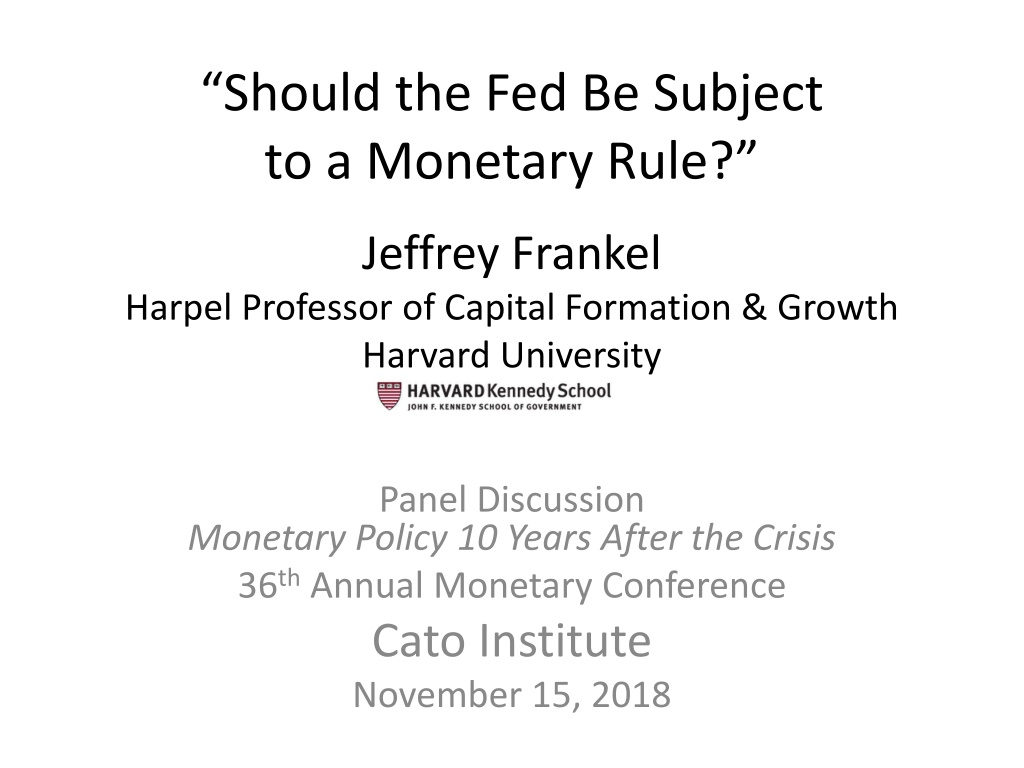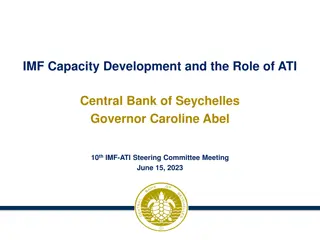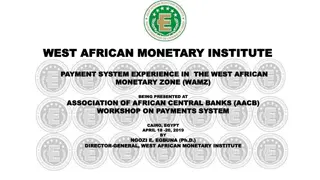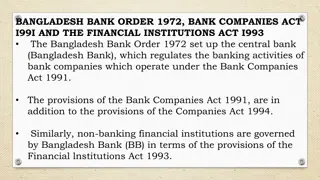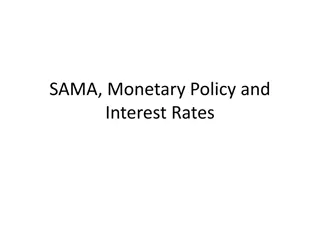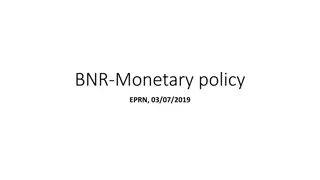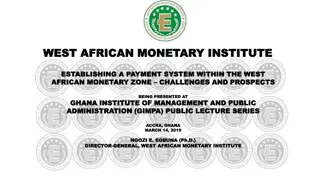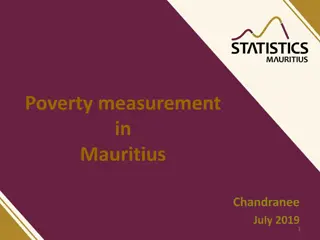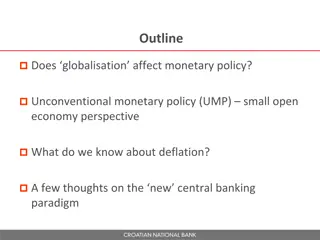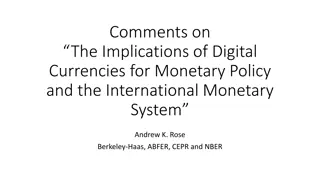Monetary Policy Constraints & Central Bank Discretion
Perspectives on monetary rules and constraints, including Nominal GDP targeting, challenges faced by central bankers in meeting commitments, and examples of unfulfilled nominal targets like M1 and inflation rates. Considerations for a loose constraint on central banks to address unforeseen shocks.
Download Presentation

Please find below an Image/Link to download the presentation.
The content on the website is provided AS IS for your information and personal use only. It may not be sold, licensed, or shared on other websites without obtaining consent from the author. Download presentation by click this link. If you encounter any issues during the download, it is possible that the publisher has removed the file from their server.
E N D
Presentation Transcript
Should the Fed Be Subject to a Monetary Rule? Jeffrey Frankel Harpel Professor of Capital Formation & Growth Harvard University Panel Discussion Monetary Policy 10 Years After the Crisis 36thAnnual Monetary Conference Cato Institute November 15, 2018
A perspective on monetary rules Two distinct questions: (1) To what extent should the central bank be constrained? versus being allowed discretion. (2) To whatever extent it is constrained by a rule, what should that rule be? I have argued for Nominal GDP targeting because it is robust with respect to supply shocks vs. CPI targets. But I am increasingly convinced that the constraint even if it is a NGDP target must be very loose. A further thought regarding a different kind of constraint: if Fed independence is compromised, monetary policy may become pro-cyclical.
I am increasingly convinced that the constraint must be very loose. Central bankers chronically end up unable to fulfill commitments to nominal targets, rules, or even their own forward guidance Not, in most cases, because they are insincere but because of unforeseen shocks.
Selected examples of inability to fulfill commitments Nominal targets M1 The Fed was forced in 1982 to abandon its experiment with monetarism , because of a big velocity shock. The Bundesbank continued to pay lip service to M1, but usually missed its targets. As do others today.
Selected examples of inability to fulfill commitments, continued Nominal targets IT Inflation targeters chronically miss their targets traditionally on the upside. Since the 2008 crisis, advanced countries have missed their targets on the downside. Japan made an all-out commitment in 2013 to raising the inflation rate to 2% (Abenomics). 5 years later, it hasn t even achieved 1% . The US mostly undershot its inflation target until 2018, despite quadrupling the monetary base and eventually re-attaining full employment anyway. A price level target would be even less credible.
Examples of inability to fulfill commitments, continued Similar stories apply to other rules, like the Taylor rule which became inoperable when unexpectedly hitting ZLB in 2008. And to forward guidance: Fed repeatedly postponed its guess-dates for interest rate hikes, e.g., when growth slowed in 2015-16. Even thresholds haven t worked: In Dec. 2012, the FOMC said it would keep interest rates at 0 at least as long as the unemployment rate remains above 6 %. That happened in April 2014 (LFPR decline). Guidance abandoned. In Aug. 2013 the Bank of England said it would not consider raising rates until UK unemployment fell to 7.0 %. That happened within 6 months (productivity shock), [long before the Bank was ready to consider tightening]. Guidance abandoned
The case for NGDP targeting, at 1-2 year horizon It is more likely you can live with the commitment despite unknown shocks: More robust than M1 targeting which is vulnerable to velocity shocks: NGDP automatically offsets them. More robust than Inflation Targeting which is vulnerable to supply shocks: NGDPT divides them equally between GDP & inflation.
If the target is to be NGDP, how strong should the commitment be? Not strong. NGDP target may be as hard to attain as other targets. My mild proposal: Add a row for Nominal GDP to the FOMC s Summary of Economic Projections, even if the Governors and district presidents who fill out the SEP table were simply to get their projected NGDP growth numbers by taking the sum of the real growth row and the (PCE) inflation rate row of table. But I would prefer that NGDP be reported in the 1strow of the SEP table before the rows for real growth, unemployment, inflation, & fed funds rate, and that the public be allowed to infer that the Fed was now paying some attention to NGDP.
SEP table in June 2018 Change in nominal GDP
Finally, a different kind of constraint: If Fed independence is compromised i.e., if Congress or the White House succeeds in reining it in, monetary policy could become pro-cyclical. Consider some quotes Nov. 15, 2010 (unemployment = 9.8%), WSJ letter from 23 conservative economic and financial leaders protested the Fed s monetary easing, foreseeing currency debasement and inflation. Sept. 29, 2011 (unemployment = 9.0%), Donald Trump: The Fed's reckless policies of low interest and flooding the market with dollars needs to be stopped or we will face record inflation. Oct. 11, 2018 (unemployment = 3.7%), Donald Trump: the Fed is out of control and July 19: I am not happy about [interest-rate increases] . This and other historical evidence suggests that if the politicians who want to bring the Fed under control got their way, they could tighten monetary policy when unemployment exceeded 9 % and loosen when lower than 4 %. Let the Fed do its job!
